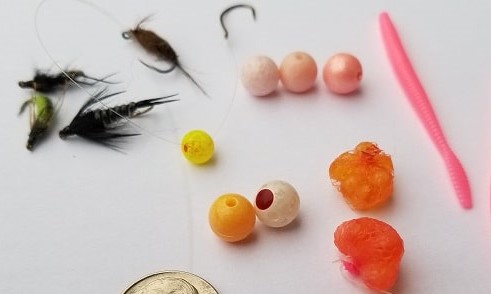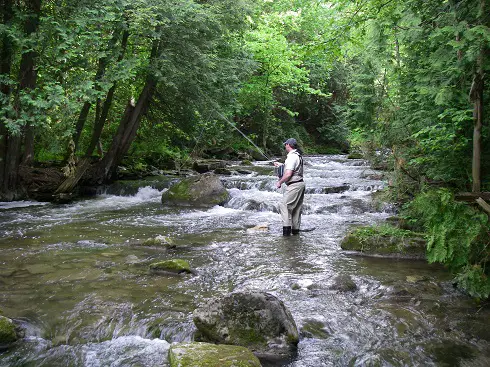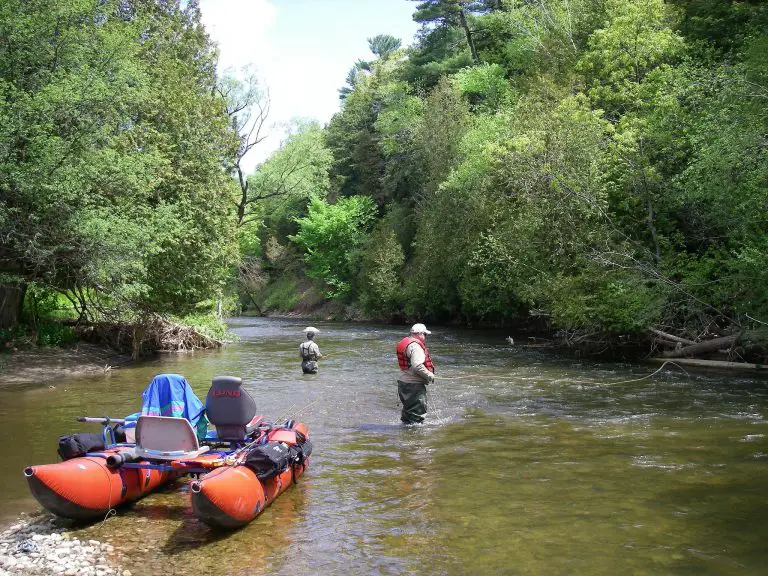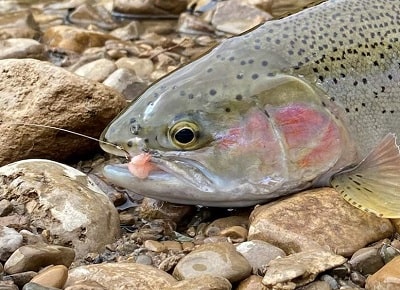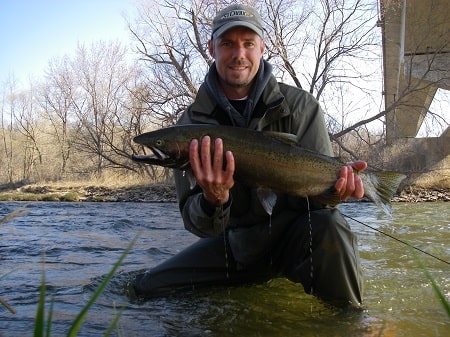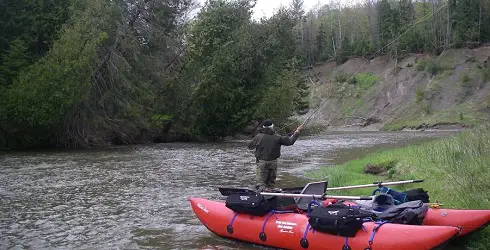Steelhead Leader Setup: Centerpin and Float Fishing Leader
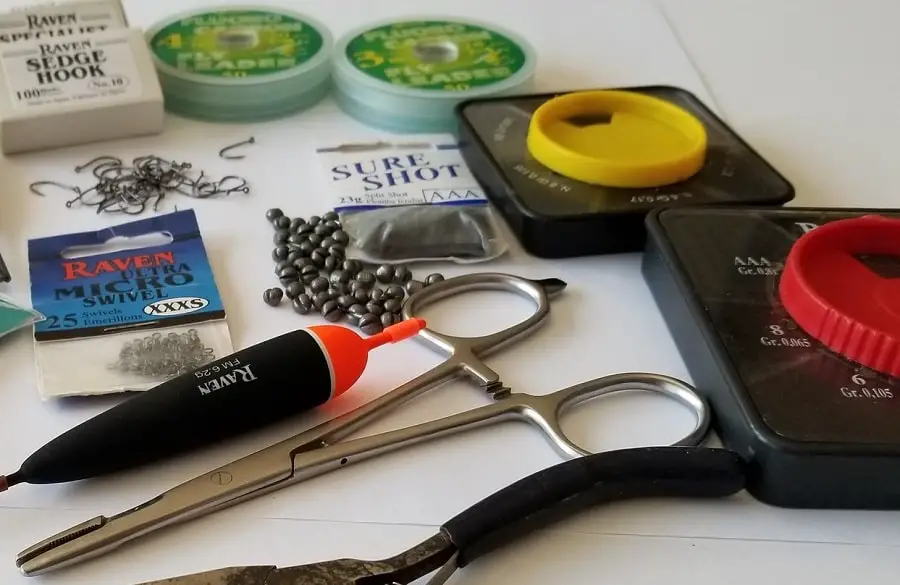
Float fishing is when you present your bait to trout, steelhead, or salmon below a float. The steelhead leader setup is an important part of this method, and I use and teach this setup to my clients.
The steelhead leader setup will include:
- A river float
- two sizes of leader line
- swivels
- weights
- Hooks
The proper float fishing leader setup will allow the angler to present the bait more effectively. Anglers that use the right float fishing leader setup will catch more trout, steelhead, and salmon.
Float Fishing Steelhead Leader / Centerpin Steelhead Leader
Float fishing with a spinning reel and float fishing with a Centerpin reel is basically the same thing, and they both use the same steelhead leader setup.
You need to make sure everything on the steelhead leader setup is perfect. Using the wrong weight or wrong leader line or the wrong hooks can affect your performance. You can see the full leader set up below and I will discuss each part of the leader.
Floats, AKA Bobbers
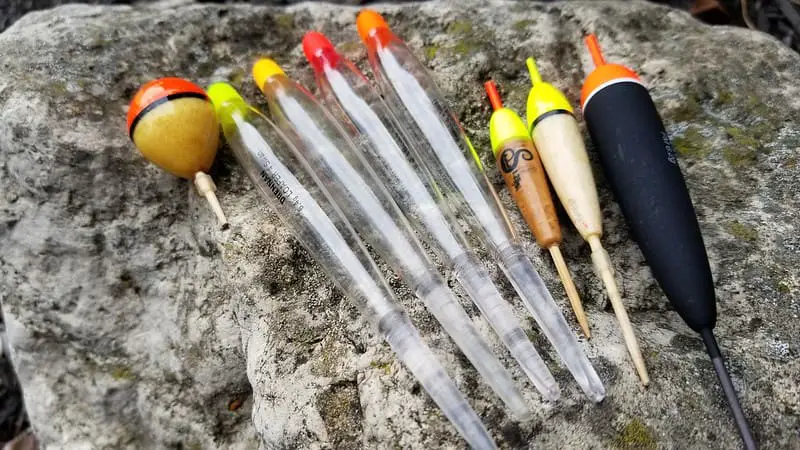
In float fishing, we use floats which to some anglers are also known as bobbers. The correct term for Bobbers that are designed specifically for river fishing is a float. A float is part of the entire float fishing leader setup.
The best floats for most river conditions are the Raven FM Floats or the clear Drennan Loafer floats for very clear water situations.
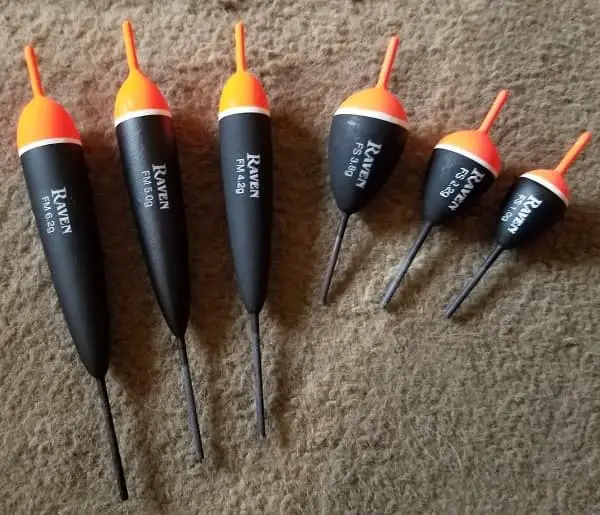
The reason I like the Raven floats is that they have a pointed tip section that helps anglers control the angle of the leader which in turn helps control the speed of the bait.
The pointed tip also helps you find the bottom easier.
Both of these things are very important for maximizing your success and part of what I consider the 4 fundamentals of successful float fishing.
The combination of the float and a good steelhead leader setup will benefit you a lot.
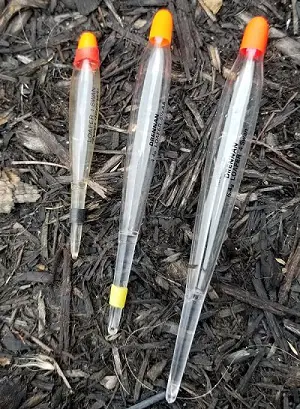
A clear float like the Drennan Loafer floats are great in low clear water situations when the fish are nervous. These floats are very stealthy and will spook less fish.
I only use them under these conditions because the colored part of the float is hard to see from a distance and under situations with high glare on the water.
Not sure what float to get, check out my page 5 Best Centerpin Floats For 2021 – see that at www.troutandsteelhead.net
Just because you have the right float and the right leader doesn’t mean you will start catching fish, you need to know how to fish it all effectively. You can see more about float fishing and the four fundamentals on my page Centerpin Fishing: An Expert Centerpin Guide Explains It – see that at www.troutandsteelhead.net
Leaders For Float Fishing Leader Setup.
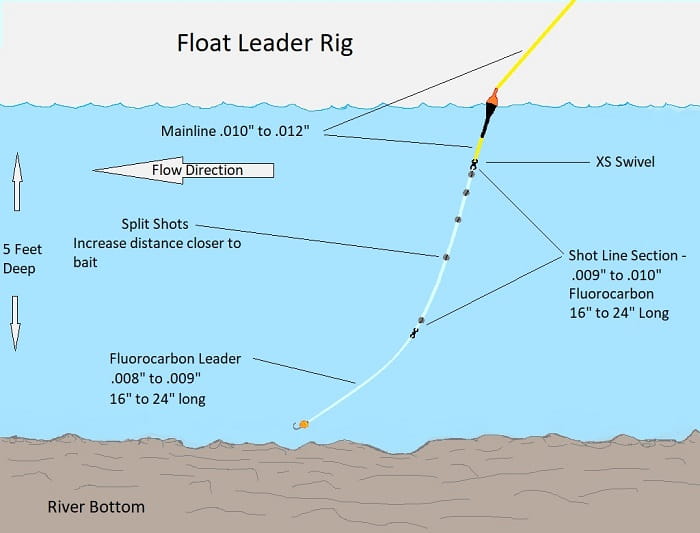
The leader material that you use is a very important part of your steelhead leader setup.
Using the wrong length of leader will cause problems and using the wrong strength of leader can either prevent fish from biting the line because they can see the thick leader, or you can break off a lot of fish if your leader is too thin.
For your steelhead leader setup, I highly recommend using a high-quality brand of Fluorocarbon leader. It also needs to be the right pound test for the type of river and the type of fish you will be fishing for.
In big rivers with big steelhead and fast currents, I will use a stronger leader. I will also use stronger leaders in rivers with lots of logs and wood to help me steer large fish away from log jams.
In smaller rivers or in slower, clearer water, I will use a thinner, weaker leader because in slower water, the fish have more time to inspect the bait and the leader and they may see a thicker leader and avoid it.
For big salmon, I will use a stronger leader to be able to control them when they make long runs.
You will need two different leader sizes for your steelhead leader setup. You want a stronger size for what I call the shot-line. The shot-line is the section of line where you put all your weights, aka your split shots.
You will then need a lighter section of the leader line for the bottom section where the hook and bait go. This section of the line needs to be the right size for the size of the fish and the type of water you will be fishing as discussed above. I will tell you what I use shortly.
IMPORTANT NOTE: Not all leaders are rated properly when it comes to the pound test on the label so don’t go by this rating. Instead, always go by the diameter listed on the spool.
Here is an example of this. These three brands that I will mention below all have a 0.20mm diameter and through my extensive use I believe they all break at the same pound test, but . . . . Drennan brand says their 0.20mm line is 4lbs on the label, Seaguars 0.20mm leader says 6 pounds on the label, and Rio says their 0.20mm says 8lb on the label.
Remember they are all the exact same diameter and should all be the same pound test which they probably are, except for the number on the label.
The reason this is so important is that if I say go use the 8lb test for Great Lakes steelhead and you go buy Drennan brand’s 8lb test, it will be so thick that the fish will see it, and you won’t get any bites.
In fact, I have guided clients that have come out with me because they can’t catch any steelhead and when I ask them what leader line they are using and they say 6 pound Drennan I know that’s a huge part of their problem.
When I tell my clients what leader they need to use, I always tell them to ignore the pound rating on the label and buy their leader based on the diameter.
For the bottom leader section, these are my leader size recommendations for different float fishing leader setups and conditions.
- Trout up to 5 pounds – slower and very clear water – 0.12mm to 0.16mm
- Trout up to 5 pounds – Faster water – 0.16 to 0.20mm
- Large trout and Great Lakes steelhead – smaller rivers, or very clear and slower water – 0.18mm or 0.20mm
- Large trout and Great Lakes steelhead – Medium-sized river of 20 to 60 feet wide with normal clarity conditions – 0.20mm to 0.22mm leader.
- Large trout and Great Lakes steelhead in large to extra-large rivers with fast flows—0.22mm for very clear and 0.24mm or 0.25mm for normal clarity.
- West Coast Steelhead – 0.24mm to 0.26mm leader
- Great Lakes Salmon – 0.22mm on low clear rivers where you can chase the salmon if you need to. 0.24mm to 0.26mm leader on larger faster-flowing rivers.
- West Coast Salmon – 0.26mm to 0.32mm
For your steelhead leader set-up, you will need two sizes of leaders. The leader for the shot line should be one or two sizes up (two sizes heavier) than the lower leader size, but there is a catch. . . .
You also need to make sure the shot line is 1 or 2 sizes lighter than your main float line that comes off your reel. If your shot line is heavier than your mainline, when you break off, it could break the mainline.
Here’s an example. Mainline 0.26mm, shot-line 0.24mm, leader to the hook 0.22.
Swivels and Weights
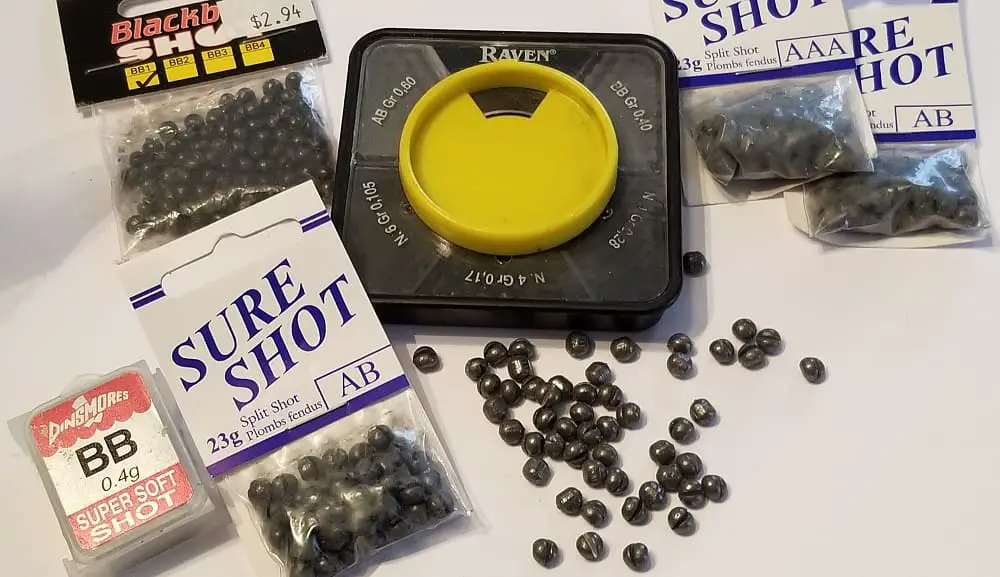
You will need to use the right swivels and the right weights for this steelhead leader setup.
For the section of the leader that I call the shot line, you will need two swivels. I use the Raven Micro Swivels. You can get them at FishUSA.com
You will need the right weights which are called split shots. The best weights are the lead split shots that are the dark and round. For lead split shots, I use the Sure Shot brand from FishUSA.com or from Amazon
Some areas have banned lead split shots so the next best thing is the Tin split shots by Orvis. You can get them at FishUSA.com – Orvis Non-Toxic Oval Split Shot
I use the same weight for my fly-fishing steelhead leader setup and for the float-fishing steelhead leader setup. For more on the best weights that I recommend and use go to my page Weights For Fly Fishing: Everything You Need To Know – see that at www.troutandsteelhead.net
Hooks

You are going to need different hooks and different sizes depending on the bait you use and the fish you are fishing for. You will want smaller hooks for smaller baits and bigger hooks for bigger baits and for bigger fish.
Hooks are part of the overall steelhead leader setup and using the right hooks will improve your success.
I have an entire page on the best hooks for float fishing. In summary, this is what I suggest
Raven Sedge Hooks or Raven Specimen Hooks in size 8 or 10 for plastic worms, spawn sacs the size of a nickle, beads, or other baits of this size.
Raven Specemin hooks and Gamakatsu- Size 4 or 6 for extra-large rivers and large boats like dew worms, large spawn sacs, skein, crawfish larger minnows. You can get these at Fishheads.com
For more detailed info on hooks, see my page 4 Best Float Fishing Hooks.
The bait is just as important as the hook you use it with so check out my page on the Best Baits for Steelhead and Trout. – see that at www.troutandsteelhead.net
How Long Should A Steelhead Leader Be
Your steelhead leader should be the length of your shallowest spot. Most rivers under 10 feet deep will have some deep pools and some shallow pools. By using a steelhead leader made for the shallowest spot, you can simply slide your float up or down to get the desired length.
If you make your leader 6 feet long it’s difficult to make it short enough to fish a 3-foot spot. But if you make your steelhead leader 3 feet long it’s easy to slide you float 5 feet up the line to fish an 8-foot spot. A short leader is usually better.
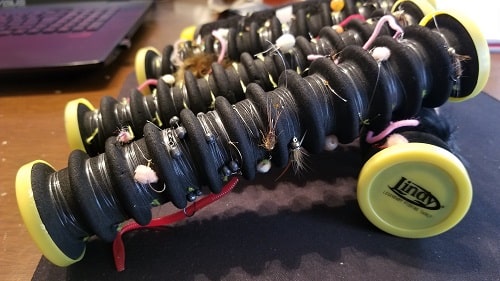
Another very good option or method that I use is to use a short leader in shallower spots and a longer leader in deeper spots.
I will often have two different steelhead leader setups pre-rigged and ready to go on a leader holder like the one in the picture.
If I move to a deeper spot, I just remove the short leader, and wrap it up, and add the new leader with one knot. It’s quick and easy. You can the leader holders that I use, get the Linde Leader Rigger at Bass Pro Shops -HERE or at Amazon-HERE
I rarely float fish in spots less than 3 feet deep or in pocket water, but at times, these can be where the steelhead and trout are holding. If a spot is less than three feet deep I will often switch up and use my advanced bottom bouncing methods instead.
The advanced bottom bouncing method is the most productive method in shallow water or when small pocket water fishing. You can see my advanced bottom bouncing method on my page Bottom Bouncing – 5 Proven Guide Tips For More Fish – see that at www.troutandsteelhead.net
Build Your Float Fishing Leader Setup
Now that you have all the right gear, you can start building your steelhead fishing leader setup. The first step to building a good float fishing leader is the shot-line.
Step 1 – Build your shot line
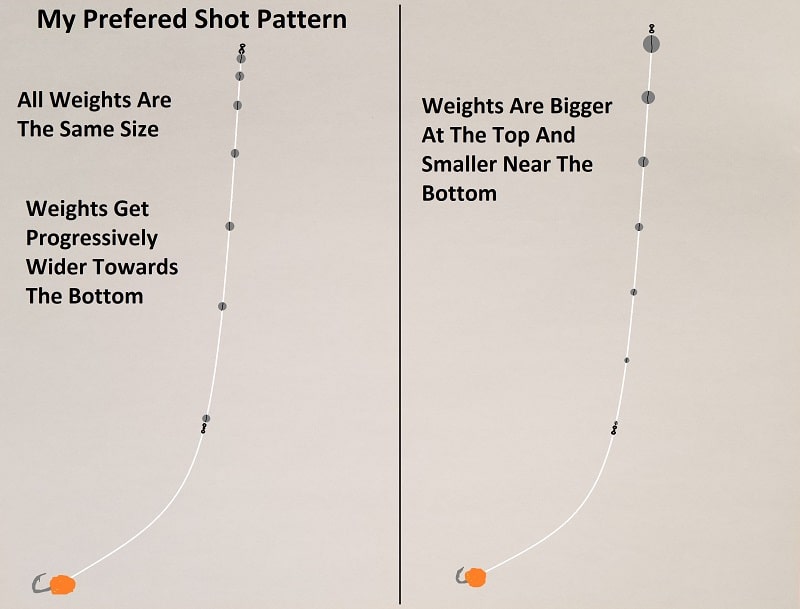
My shot lines are usually about 18 to 20 inches long. That way I can add a 14 to 16-inch lower leader for a total of 36” ( 3 feet long) which is perfect for those spots that are only 3 feet deep. If I need it deeper I just slide my float up the line. I have fished spots 12 feet deep with a 20” shotline and a total leader length of 3 feet.
When fishing mostly deeper water I will make my shot line longer. To figure out how long I make my shot line 14 to 16 inches shorter than the shallowest spot. Eg. If the shallowest spot on the river is 5 feet (60 inches) then my shot line will be 44 inches long so when I add a 16-inch leader the entire leader will be 5 feet long.
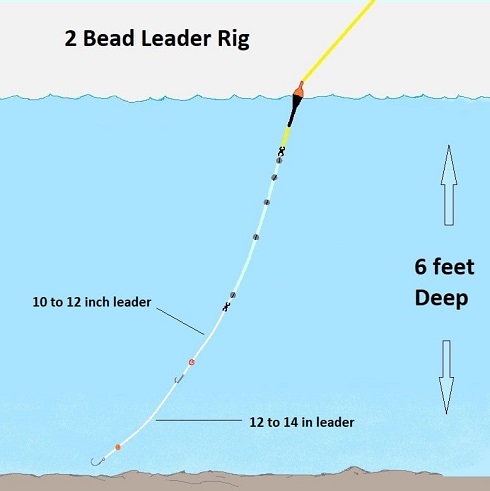
You can also add a longer lower leader to the bottom to get some extra length.
To get extra length, I will often add a second leader which is tied off the bend of the first hook so I can run two baits.
This will give you the extra length you need, just make sure you are legally allowed to use two baits like this in your area.
Not every river will be like the ones I fish so I suggest that if you know what the shallowest spot you will be fishing is, you want your shot line to be about 14 to 16 inches shorter than that.
Step 2 – Add Swivels
Once you have determined how long your shot line should be add 3 to 4 inches and cut off a piece of leader from the spool. The extra 3 or 4 inches is for the waste from the two knots when you tie on a swivel at both ends of the leader.
Step 3 – Add Weights
You need the right amount of weight for the river you are fishing.
There are 2 ways to do the weights on your float fishing leader setup. The first way and the one I use and recommend is to use only one size of weight and to space the weights closer together at the top near the float and space them wider apart near the bait. You can see this in the above picture on the left.
This gives you a slight downriver curve in your leader, which is what you want. For average-sized rivers of 20 to 60 feet wide and 3 to 10 feet deep, I will use size AB shots from the Sure Shot brand. For a deeper, faster rivers, I will go up 1 or 2 sizes. I will also only use enough shots for the size of the float that you need to use. Too many shots will sink your float and too few shots and your float won’t sit properly.
The other float fishing leader setup would use 5 to 8 different sized weights equally spaced with the largest weight at the top near the float and the smallest weight nearest to the bottom near the bait.
Step 4 – Add The Lower Leader – Also Know As The Tippet
The tippet is the lowest part or the tip of the leader. This is the part of the leader where your bait attaches to, and it needs to be the right size for the size of the fish, and the speed of the current so it’s important to get this right.
Step 5 – Add the right hook
the hook can be changed at any time as needed. Use a hook appropriate to the size of the fish and the size of the bait. As a rule of thumb, I try to keep my hooks on the bigger size. I want my hooks to be small enough to not be seen and to not affect the movement of the boat I’m using, but big enough and strong enough to not bend or break on a big fish.
Step 6 – Attach To The Mainline
Before you attach your float fishing leader you need to add your float to the mainline. Once the float or at least the float caps are on the mainline you can now tie the mainline to your top swivel.
Make sure you use a good mainline. The mainline should be as light as possible and buoyant. Not many are like this so be sure to check out my article on the Best Lines For Float Fishing and Centerpining.
Tight Lines
Graham

